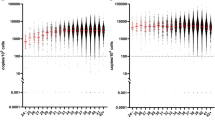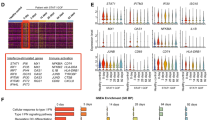Abstract
The highest annual increase in the incidence of type 1 diabetes (T1D) in children under the age of 5 years and aggressive process of β-cell destruction in this age group indicate the need to assess the immune system. The aim of this study was to evaluate regulatory T cells (Tregs) frequency in the peripheral blood of children <5 years of age with newly diagnosed T1D in comparison with diabetic children diagnosed at a later age and healthy controls. 40 children with newly diagnosed T1D (20 children <5 years of age and 20 older patients) and 40 age-matched controls were included in this study. Flow cytometric analysis of Tregs was performed using the following markers: CD4, CD25, CD127, FoxP3, IL-10, and TGF-β. Apoptosis was measured using anti-active caspase 3 monoclonal antibody. Fasting C-peptide and HbA1c were monitored as well. We showed that T1D children <5 years had lower C-peptide concentration than diabetic children ≥5 years of age (0.32 vs. 0.80 ng/ml, respectively, p = 0.0005). There was lower frequency of CD4+CD25highCD127lowFoxP3+ Tregs in T1D children <5 years than ≥5 years of age (0.87 vs. 1.56 %, respectively, p = 0.017). Diabetic children <5 years had lower CD4+CD25highCD127lowFoxP3+, CD4+CD25highIL-10, and CD4+CD25highTGF-β Tregs compared to age-matched controls. There was no difference in Tregs apoptosis between the examined groups. This study highlights the distinctiveness of diabetes in children <5 years of age. Understanding the differences of immune system activity in the young diabetic children would open the way to identify children at risk for T1D and enables the use of novel forms of intervention.




Similar content being viewed by others
References
Abdul-Rasoul M, Habib H, Al-Khouly M (2006) ‘The honeymoon phase’ in children with type 1 diabetes mellitus: frequency, duration, and influential factors. Pediatr Diabetes 7:101–107
Bober E, Dundar B, Buyukgebiz A (2001) Partial remission phase and metabolic control in type 1 diabetes mellitus in children and adolescents. J Pediatr Endocrinol Metab 14:435–441
Bowden SA, Duck MM, Hoffman RP (2008) Young children (<5 yr) and adolescents (>12 yr) with type 1 diabetes mellitus have low rate of partial remission: diabetic ketoacidosis is an important risk factor. Pediatr Diabetes 9(Pt 1):197–201
Brusko TM, Wasserfall CH, Clare-Salzler MJ et al (2005) Functional defects and the influence of age on the frequency of CD4+CD25+T-cells in type 1 diabetes. Diabetes 54:1407–1414
Cheatem D, Ganesh BB, Gangi E et al (2009) Modulation of dendritic cells using granulocyte-macrophage colony-stimulating factor (GM-CSF) delays type 1 diabetes by enhancing CD4+CD25+regulatory T cell function. Clin Immunol 131:260–270
Chen C, Liu CP (2009) Regulatory function of a novel population of mouse autoantigen-specific Foxp3 regulatory T cells depends on IFN-gamma, NO, and contact with target cells. PLoS ONE 4:e7863
Craig M, Hattersley A, Donaghue K (2009) Definition, epidemiology, diagnosis and classification of diabetes in children and adolescents. Pediatr Diabetes 10(suppl 12):3–12
Glisic-Milosavljevic S, Wang T, Koppen M et al (2007a) Dynamic changes in CD4+CD25+high T cell apoptosis after the diagnosis of type 1 diabetes. Clin Exp Immunol 150:75–82
Glisic-Milosavljevic S, Waukau J, Jailwala P et al (2007b) At risk and recent-onset type 1 diabetic subjects have increased apoptosis in the CD4+CD25+high T cell fraction. PLoS ONE 2:e146
Greenbaum CJ, Mandrup-Poulsen T, McGee PF et al (2008) Mixed-meal tolerance test versus glucagon stimulation test for the assessment of β-cell function in therapeutic trials in type 1 diabetes. Diabetes Care 31:1966–1971
Karges B, Durinovic-Belló I, Heinze E et al (2006) Immunological mechanisms associated with long-term remission of human type 1 diabetes. Diabetes Metab Res Rev 22:184–189
Komulainen J, Lounamaa R, Knip M et al (1996) Ketoacidosis at the diagnosis of type 1 (insulin dependent) diabetes mellitus is related to poor residual cell function. Arch Dis Child 75:410–415
Kukreja A, Cost G, Marker J et al (2002) Multiple immuno-regulatory defects in type-1 diabetes. J Clin Invest 109:131–140
Lindley S, Dayan CM, Bishop A et al (2005) Defective suppressor function in CD4(+)CD25(+) T-cells from patients with type 1 diabetes. Diabetes 54:92–99
Liu W, Putnam AL, Xu-Yu Z et al (2006) CD127 expression inversely correlates with FoxP3 and suppressive function of human CD4+Treg cells. J Exp Med 203:1701–1711
Łuczyński W, Wawrusiewicz-Kurylonek N, Stasiak-Barmuta A et al (2009) Diminished expression of ICOS, GITR and CTLA-4 at the mRNA level in T regulatory cells of children with newly diagnosed type 1 diabetes. Acta Biochim Pol 56:361–370
Patterson CC, Dahlquist GG, Gyürüs E et al (2009) Incidence trends for childhood type 1 diabetes in Europe during 1989–2003 and predicted new cases 2005–20: a multicentre prospective registration study. Lancet 373:2027–2033
Perez N, Karumuthil-Melethil S, Li R et al (2008) Preferential costimulation by CD80 results in IL-10-dependent TGF-beta1(+)-adaptive regulatory T cell generation. J Immunol 180:6566–6576
Pop SM, Wong CP, Culton DA et al (2005) Single cell analysis shows decreasing FoxP3 and TGFbeta1 coexpressing CD4+CD25+regulatory T cells during autoimmune diabetes. J Exp Med 201:1333–1346
Putnam AL, Vendrame F, Dotta F et al (2005) CD4+CD25high regulatory T cells in human autoimmune diabetes. J Autoimmun 24:55–62
Ryba M, Rybarczyk-Kapturska K, Zorena K et al (2011) Lower frequency of CD62L and higher frequency of TNFR2 Tregs are associated with inflammatory conditions in type 1 diabetic patients. Mediators Inflamm 2011:645643
Sanda S, Bart O, Roep BO et al (2008) Islet antigen specific IL-10+ immune responses but not CD4+CD25+FoxP3+ cells at diagnosis predict glycemic control in type 1 diabetes. Clin Immunol 127:138–143
Sojka DK, Huang YH, Fowell DJ (2008) Mechanisms of regulatory T-cell suppression—a diverse arsenal for a moving target. Immunology 124:13–22
Szypowska A, Stelmaszczyk-Emmel A, Demkow U et al (2010) Evaluation of T regulatory cell apoptosis in children with newly recognized type 1 diabetes mellitus. Eur J Med Res 15(suppl 2):198–201
Tritt M, Sgouroudis E, d’Hennezel E et al (2008) Functional waning of naturally occurring CD4+regulatory T-cells contributes to the onset of autoimmune diabetes. Diabetes 57:113–123
Vrabelova Z, Hrotekova Z, Hladikova Z et al (2008) CD127– and FoxP3+ expression on CD25+CD4+ T regulatory cells upon specific diabetogeneic stimulation in high-risk relatives of type 1 diabetes mellitus patients. Scand J Immunol 67:404–410
Author information
Authors and Affiliations
Corresponding author
About this article
Cite this article
Szypowska, A., Stelmaszczyk-Emmel, A., Demkow, U. et al. Low Frequency of Regulatory T Cells in the Peripheral Blood of Children with Type 1 Diabetes Diagnosed under the Age of Five. Arch. Immunol. Ther. Exp. 60, 307–313 (2012). https://doi.org/10.1007/s00005-012-0177-y
Received:
Accepted:
Published:
Issue Date:
DOI: https://doi.org/10.1007/s00005-012-0177-y




